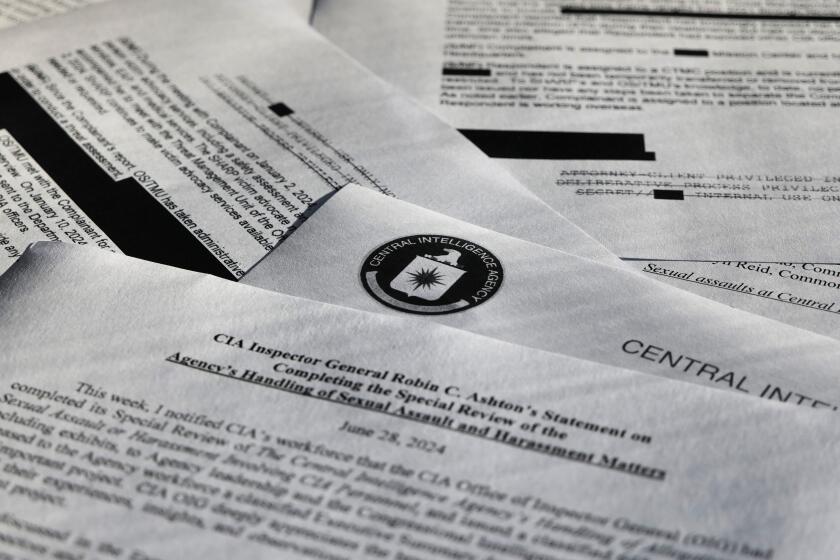Smithsonian head resigns under fire
Since 1836, when Congress accepted the bequest of James Smithson to fund “an establishment for the increase and diffusion of knowledge,” the Smithsonian Institution has amassed an enormous collection of historical relics, a lofty scientific reputation and the affection of millions of visitors.
As the 21st century approached, the nation’s largest museum complex -- with 18 museums (plus one under construction), nine research facilities and the National Zoo -- was looking a little shopworn, and board members decided that an outside executive, Lawrence M. Small, could liven things up.
Small, who had made his name in the financial community first at Citicorp and then at Fannie Mae, succeeded beyond all expectations. The new secretary of the Smithsonian brought in more than $1 billion in new support and spearheaded the reopening or refurbishing of several marquee museums.
But on Monday the Smithsonian announced his resignation, a departure marred by controversy over his personal style. During his seven-year tenure, Small, 65, showed a willingness to step on toes and a penchant for corporate-style expenseaccount amenities that left him few friends when critics gained the upper hand.
With Congress moving unilaterally to cut his salary and trim what one senator derisively called his “champagne lifestyle,” Small stepped down.
“Having spent countless days and evenings promoting the interest of the institution and having contributed over a half a million dollars of my own money as well, it was truly a labor of love,” he said in a letter of resignation submitted Saturday and accepted Sunday by the Smithsonian’s Board of Regents, where once robust-support had been dwindling.
About 70% of the Smithsonian’s $1-billion budget comes from Congress. When the Senate last Thursday froze the institution’s request for a $17-million budget increase until the secretary’s office reformed the way it does business, the action was seen as a rebuke to Small.
“I think he was really concerned about the possibility of the institution being changed fundamentally,” said Roger Sant, chairman of the board’s executive committee and one of Small’s biggest defenders. “It would be hard to ignore something like that.”
Sen. Charles E. Grassley (R-Iowa) has been leading the charge for corporate accountability at the Smithsonian, asking tough questions about such items as first-class trips by Small and his wife to Hawaii and Las Vegas, $31,000 for upholstery for his office furniture, and household expenses that included $12,000 for swimming-pool upkeep and $273,000 for housekeeping services.
“Mr. Small’s champagne lifestyle turns out to be Dom Perignon,” said Grassley, the top Republican on the Senate Finance Committee, who has made corporate governance a key topic of congressional oversight. Referring to the building where the administrative offices are located, he added: “It looks like the Smithsonian Castle has been turned into Mr. Small’s palace.”
Sen. Dianne Feinstein (D-Calif.), who as chair of the Rules Committee has oversight responsibility for the Smithsonian, was so upset by reports of Small’s excesses -- and the board’s lackadaisical response -- that she moved up, to April 11, the date of her committee’s hearings, according to her staff.
“It is my hope that Secretary Small’s resignation will help clear the air at the Smithsonian and help lead to a new era of accountability at one of our nation’s premier institutions. I believe that his compensation package, totaling $915,698 in 2007, was seriously flawed and the oversight of his spending practices lacking,” she said in a statement Monday. “Now, in the wake of his resignation, it is imperative that the Board of Regents step up to the plate and ensure much more vigorous oversight and accountability.”
Some defended Small’s expenditures as the price required for a museum director who could convince billionaires to contribute to the national cultural identity. At that he was very successful: For example, California real estate developer Kenneth E. Behring donated $80 million to the National Museum of American History; its building is now known as the Behring Center.
But the Washington Post, which has published a series of reports on Small’s expenditures, editorialized Monday that the 17-member board, with its corporate structure “minted in the 19th century,” was at fault for letting spending get out of hand.
Two of Washington’s busiest officials -- the chief justice of the United States, who by tradition is the Smithsonian’s chancellor, and the vice president -- are non-voting members. Also on the board are six members of Congress -- three from the Senate, three from the House.
“The Smithsonian is now a billion-dollar annual operation,” said the Post. “It needs an engaged board.”
Small was selected in 2000 from more than 250 candidates, extolled by the search committee as a man of vision who cared about culture and cultural diversity. An art collector and flamenco guitarist, Small said he welcomed the chance to make his avocations the stuff of daily work. “It couldn’t be more exciting,” he said.
But Small and the institution soon clashed. He angered scientists by proposing to close the Conservation and Research Center, a 3,200-acre field station near Front Royal, Va. He pleaded guilty to violating the Migratory Bird Treaty by importing, as a collector, feathers from endangered species. He was sentenced to probation and community service. And he offended historians, researchers and independent filmmakers by approving a contract that gave the cable network Showtime semi-exclusive access to Smithsonian experts and material in the archives.
On other fronts, Small thrived. He oversaw tremendous growth, adding three new buildings, including the National Museum of the American Indian, and attracting major contributions, like Walt Disney World Co.’s donation of an African art collection, estimated to be worth $20 million to $50 million. The Donald W. Reynolds Foundation provided $45 million to restore the landmark Patent Office Building, home to the National Portrait Gallery and the Smithsonian American Art Museum. The Boeing Co., in the single largest corporate monetary gift the Smithsonian has received, gave $15 million to the National Air and Space Museum.
“The guy took over a place that was really sort of falling apart,” Sant recently told a reporter. “There was hardly any fund-raising capability. He’s raised almost a billion dollars personally. What more could we have asked for?”
In the end, though, that wasn’t enough to save Small’s job. In a Senate floor speech last week, Grassley paraphrased the well-known MasterCard commercial: “Chandelier cleaning: $2,535. Pool heater: $4,225.77. Three new French doors: $14,525. Having the taxpayers and Smithsonian donors pay for your champagne lifestyle: Priceless.”
*
More to Read
Sign up for Essential California
The most important California stories and recommendations in your inbox every morning.
You may occasionally receive promotional content from the Los Angeles Times.










